Overview of Transformational Culture & Cross-Functional Teams
What would happen if you took away all the people from an organization? It wouldn’t cease to exist, but could it still function? Could it produce results?
Businesses will invest millions of dollars in cutting-edge technologies and sophisticated systems of every kind to produce better results and increase profits. At the same time, businesses forget about the people that will operate those technologies and implement those systems.
If the market and businesses could work without people, a start-up from Silicon Valley would have figured out how by now, right?
We strive to convince organizations that building an environment that respects and empowers its people is essential to their long-term survival, thus modeling the culture in the strategy development process is a necessity.
Although there is great potential in teamwork and the combined intelligence of a large group of people, it is hard to tap into it. It's impossible to force people to work together harmoniously, but there are frameworks that can create the necessary conditions.
These are not novelty ideas nor are we the first to mention them. So why are we discussing them again?
We find that there is still a large number of organizations that either doesn't have culture-related conversations or have them in a very abstract field and have a hard time implementing them.
Our aim with this piece is to remind the most important aspects of a transformational culture and offer some actionable advice, on creating a more robust organization through cross-functional teams.
We will answer the questions:
- How are business performance and culture related?
- What is a transformational culture and how to build one?
- How to build cross-functional teams that pull together?
How are Business Performance and Culture Related?
Culture consists of the values of the organization and the behaviors that are allowed in it.
There are two specific ways that culture influences business performance. The first and most powerful to remember is that the success of strategy implementation is inescapably dependent on its conflict with the currently established culture.
The second impact to business performance is through individual performance and the overall synergy of the organization. It’s simple, cultures without trust or vulnerability are rigid and destructive.
What is a Transformational Culture and How to Build One?

A transformational culture is the values and behaviors an organization has to adopt today to successfully implement its strategy tomorrow.
A culture should be in service of the vision. It's the answer to the question "Who do we have to be today to accomplish everything we set out to pursue tomorrow?". To have cultural conversations in the organization is to invite transformational change to come through the front door.
However, building a strong culture is not an easy task.
Identifying the values your company stands for is the most fundamental answer to the culture question. Try putting them in words and more specifically, associate an action (a verb) that expresses each one and not just a noun.
Instead of “Fairness” write “I will not treat a colleague differently, because I disagree with him/her”. Instead of “Honesty” write “I will tell the truth, even when it doesn’t suit me”.
Strong cultures however share two values that drive success: honesty and trust. When actions are consistent with the communicated message, integrity is formed. Integrity is the core of good leadership.
Every single decision a company makes is a piece of communication, not just words. Integrity means that these pieces of communication are consistent with the organization’s values.

Work Institutes 2020 Retention Report
Trust is the result of a safe environment. An environment where the people can be vulnerable and have the courage to express doubt and ask for help.
A person in your organization is being vulnerable when he raises his hand and admits “I need help”, “I screwed up”, “I’m not sure how to go on from here, I need guidance”.
And only when people feel safe can they admit they were wrong. It is the responsibility of leadership to create a safe environment and the only way to do it is to practice empathy.
Cultures can't be mandated. Leadership can't order transformational change into becoming reality.
Treating the changes the leadership hopes to bring into the organization like it treats a marketing campaign - with a starting date, motivational videos etc- is bound to fail.
However, leadership can absolutely reinforce the culture they wish to build and watch the changes over time.
Build trust by exercising empathy. When a person’s performance is substandard don’t threaten them or “warn” them, instead, coach them. Empathy is caring about another person as a human being, not just their output.
If people face serious problems in their personal life (e.g. they have a sick kid, they’re getting a divorce), their work performance will inevitably be affected. The second top category of employee retention in 2019 was work-life balance. Keep an open mind.
Reinforce desired behavior and call out unwanted behavior. Once you have identified the values of your organization and the behaviors that you want to tolerate, reinforce them. Reward people who act the way you want, who demonstrate the values your culture advocates.
On the other hand, call out as fast as possible behaviors that go against the values you want to be established. These two are the most direct ways to communicate your principles.
Adjust the metrics. If you want people to take those reinforcements seriously, make sure you model your desired behaviors in the metrics. What gets measured gets done.
Shift your focus from results and include progress, too. If, for example, you want people to innovate more, reward the person who brought in the most ideas, not only the person with the best one.
Provide tasks, not instructions. Give your people clear destinations and the freedom to choose the route themselves. That’s what empowering is all about. This way you communicate that you trust them and have the confidence they will do the job you assigned them to.
This is often hard for people who got promoted by doing the job their subordinates now do. This brings us to the next point.
Offer training and guidance. Not all people are born leaders. Sometimes good people become toxic leaders because they don't know any better. It is your responsibility to train them in effective confrontation, listening, communication, giving and receiving feedback etc.
It's only possible when you have an environment where a leader feels safe enough to express when she needs these things.
The Biggest Stumbling Blocks for New Leaders

Model the behavior at the top. If the new behaviors are to be adopted, leaders must be the first to display them. Do you want to foster trust? Then build trusting relationships with those that report directly to you.
How do you expect people to behave in a certain way, if they never see you behave like that?
Create a sense of belonging. Care for your people and offer recurring belonging cues. When you pass by a rank-and-file employee, ask him if he needs anything, even if he isn’t in your department.
Follow up with a simple question on the progress of the illness of an employee’s family member. Learn what motivates your people and, if you deem it proper, change their role in the organization to avoid boredom or burnout.

How to Build Cross-Functional Teams That Pull Together?
A cross-functional team is a team of employees that has a range of different skill sets that are working on a project together towards a common goal. Cross-functional teams often include employees from all aspects of a business.
This can include different departments and levels of the business, even people external to the business.
A successful cross-functional team that pulls together is a trusting team with little uncertainty. To build such a team, you need to cultivate trust between the members and eliminate any ambiguity concerning the objectives of the team and the roles and responsibilities of each member.
The first component is highly dependent on the established culture of the organization unless the team has many new recruits or is relatively detached from the rest of the organization. We covered that part earlier.
Trust and meaningful relationships are powerful forces that drive organizations forward. But sometimes cross-functional teams need more direct guidance to be successful.
Sometimes, even though there is a strong culture, changes are met with resistance. What is the solution? In four words, activate the middle management.
Middle managers have a tough job. They have to connect the vision of the company with everyday tactics and inform the top of the feedback from the front line.
But what can they do when they are faced with skepticism about the new processes that delay viable team creation when pep talks won’t cut it?
Create a sense of urgency. Set a pressing deadline. Pressing doesn’t mean impossible.
It means it’s so demanding that it forces people to focus on what is essential and to put aside their skepticism for the new strategy, their interdepartmental differences, and any other agenda. Essentially it eliminates concerns and doesn’t allow deviations from the set goals and objectives.
Design detailed activities and requirements. Hand to your people detailed tasks that they have to accomplish, clear goals, and clear objectives. Prioritize the problems they have to solve and determine the deliverables.
Eliminate all and every ambiguity from to whom is every task assigned to when they have to report back.
Caution: these tactics shouldn’t be used frequently. The desired effect isn’t achieved due to the micromanaging of the situation.
It is achieved due to the success the people experience with the completion of the project. That experience reinforces the notion that the new changes are in fact beneficial.
Drive authority downwards. One beneficial result of the last tactic is that it raises accountability, which is something you should strive to achieve. It is easier to move forward when the role of each member is clear and the responsibilities are distributed.
Assign a leader. Even though promoting team accountability is key in ensuring that everybody tries to cooperate and nobody tries to outdo the other, a leader is a catalytic factor in the success of the team.
When there is a person who is accountable for that success, they spend extra energy to ensure that the team is working towards the desired objectives. They offer support to each member of the team and help them utilize their strengths.
Parting Thoughts for Leadership
.png)
Leadership must realize that culture can’t be mandated. Written rules and regulations are necessary, of course. But they rarely are enough. Actually, they never are at identifying and expressing the values and the feeling of a company's culture.
There exists a second, separate set of implicit rules that governs the everyday working life of the people in the organization. That second set of rules is determined by every decision the company makes, however small or insignificant it may seem.
Humans are social animals and very acute in detecting inconsistencies. Intention matters and it is always revealed through action - or inaction. Conflicting intentions are a serious problem.
They usually manifest as a clear, known intention and a fear implicitly or explicitly expressed through a decision. It is the mark of a brave leader to identify the conflict early and make the uncomfortable decision that will lead to a real cultural transformation.
Big changes can’t be achieved tomorrow. However, you can make the first step today towards the future you envision with simple actions.
Schedule a meeting to have a conversation about your culture, show the people that report directly to you that you care. Show trust and give a little time, a little energy to other people. Inspire them so they adopt your own example.





.png)
.jpg)
.jpg)
%20(1)%20(1)%20(1)%20(1)%20(1).png)



